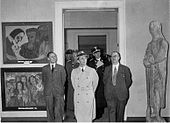Nazis Establish Reich Chamber of Culture Then Exclude Jews From the Arts
| Reichskulturkammer | |
 | |
 Minister Goebbels and his Staatssekretär, Walther Funk, at the Reich Ministry building of Propaganda. Referent des Ministers Karl Hanke is in the background (1937). | |
| Agency overview | |
|---|---|
| Formed | 22 September 1933 (1933-09-22) |
| Dissolved | viii May 1945 (1945-05-08) |
| Jurisdiction | Nazi Germany |
| Headquarters | Wilhelmplatz, Berlin |
| Minister responsible |
|
| Bureau executive |
|
The Reich Chamber of Civilisation ( Reichskulturkammer ) was a government agency in Nazi Germany. It was established by law on 22 September 1933 in the grade of the Gleichschaltung procedure at the instigation of Reich Minister Joseph Goebbels as a professional organization of all German language creative artists.[ane] Defying the competing ambitions of the German Labour Front (DAF) under Goebbels' rival Robert Ley, it was meant to gain control over the entire cultural life in Germany creating and promoting Aryan art consistent with Nazi ideals.
Every artist had to apply for membership on presentation of an Aryan certificate. A rejected inscription de facto resulted in an occupational ban.
Construction and organization [edit]
The RKK was affiliated with the Reich Ministry of Public Enlightenment and Propaganda with its seat on Wilhelmplatz in Berlin. Headed by Goebbels himself, a state secretary of his ministry served as vice president:

The 1935 Reich Chamber of Music decree to the Berlin musician Werner Liebenthal dictating the immediate cessation of his professional activity.
- Walther Funk (1933–1938)
- Karl Hanke (1938–1941)
- Leopold Gutterer (1941–1944)
- Werner Naumann (1944–1945)
SS officer Hans Hinkel was one of the officers in accuse of the sleeping room and Goebbels' special commissioner for the removal of Jews from German cultural life.
Dissimilar subdivisions of the RKK dealt with film, music, visual arts, theatre, literature, media, and radio, organized in seven departments:
- Reichsfilmkammer, headed by Carl Froelich from 1939
- Reichsmusikkammer, headed past Richard Strauss, from 1935 by Peter Raabe
- Reichskammer der bildenden Künste ("Reich Chamber of Fine Arts") (de), headed by Eugen Hönig from 1933, by Adolf Ziegler from 1936, and by Wilhelm Kreis from 1943
- Reichstheaterkammer, headed by Rainer Schlösser 1935–1938, by Paul Hartmann from 1942
- Reichsschrifttumskammer, headed past Hans-Friedrich Blunck, from 1935 by Hanns Johst
- Reichspressekammer, headed past Max Amann
- Reichsrundfunkkammer (tasks assigned to Reichs-Rundfunk-Gesellschaft in 1939)
The RKK was ultimately dissolved and its assets confiscated by Law no. 2 (October 10, 1945) of the Allied Control Council. Footage and athenaeum material are kept by the German Federal Archives (Bundesarchiv) and the Berlin Document Middle.
Degenerate art [edit]

Goebbels visits the 1938 Entartete Kunst exhibition in Munich
The RKK played a significant part in the Nazi oppression of Modern art, defamed every bit "Cultural Bolshevism". Ane notable project of the Bildende Künste (Fine Arts) division under Adolf Ziegler was the Entartete Kunst exhibition, of works deemed "degenerate."[2] Opened in July 1937 at the Hofgarten in Munich, touring exhibitions were held from 1938 to 1941 in several major German cities such every bit Berlin, Leipzig, Düsseldorf, Salzburg, and Hamburg. Attendance was measured in the millions (perhaps largely because entrance was gratis), and the then-called degenerate art may have been more pop with the public than the Nazis anticipated. Goebbels had supported German expressionists until Hitler intervened and expressed his cloy at artists such as Max Liebermann and Emil Nolde. To raise greenbacks for the Nazi war effort, certain art dealers were authorised to emigrate to New York to sell the art.[three]
Encounter also [edit]
- Haus der Kunst
- Curt Valentin
References [edit]
Notes
- ^ "Culture in the Third Reich: Overview". Holocaust Encyclopedia. The states Holocaust Memorial Museum. June ten, 2013. Retrieved ix March 2014.
- ^ "Culture in the Tertiary Reich: Disseminating the Nazi Worldview". Holocaust Encyclopedia. United states of america Holocaust Memorial Museum. June ten, 2013. Retrieved 9 March 2014.
- ^ Cohan, William D. (2011-11-17). "MoMA'southward Problematic Provenances". ARTnews.com . Retrieved 2022-01-22 .
Past November 1936, Valentin had fabricated his deal with the Nazis that would allow him to emigrate to New York and to sell "degenerate art" to help fund the war endeavour.
{{cite spider web}}: CS1 maint: url-status (link)
Bibliography
- Steinweis, Alan Eastward. (1996). Art, ideology, & economic science in Nazi Federal republic of germany: the Reich chambers of music, theater, and the visual arts. Chapel Colina, NC: Academy of North Carolina Press. ISBN978-0-8078-4607-0.
Source: https://en.wikipedia.org/wiki/Reich_Chamber_of_Culture
0 Response to "Nazis Establish Reich Chamber of Culture Then Exclude Jews From the Arts"
Post a Comment